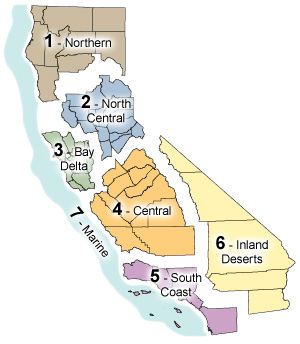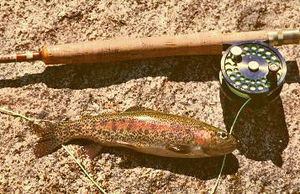California Department of Fish and Wildlife - Central Region
An environmental summary created by the ENVS 560/L Watershed Systems class at CSUMB.

Contents
Summary
California Department of Fish and Wildlife Central Region manages and protects the state's fish, wildlife, plant and native habitats for Fresno, Kern, Kings, Madera, Mariposa, Merced, Monterey, San Benito, San Luis Obispo, Stanislaus, Tulare and Tuolumne counties. The main office is located at 1234 E. Shaw Avenue Fresno, CA 93710
Protected Areas


The Central Region of California Department of Fish and Wildlife manages 31 protected areas. The protected areas are broadly categorized as:[1]
- Ecological Reserves (ER)
- Wildlife Areas (WA)
| Type | Wildlife Areas | County |
|---|---|---|
| ER | Alkali Sink Ecological Reserve | Fresno |
| WA | Big Sandy Wildlife Area | San Luis Obispo |
| ER | Allensworth Ecological Reserve | Tulare |
| WA | Cottonwood Creek Wildlife Area | Merced |
| ER | Buttonwillow Ecological Reserve | Fresno |
| WA | Kinsman Flat Wildlife Area | Madera |
| ER | Canebrake Ecological Reserve | Kern |
| WA | Little Panoche Reservoir Wildlife Area | Madera |
| ER | Elkhorn Slough Ecological Reserve | Monterey |
| WA | Los Banos Wildlife Area | Merced |
| ER | Fremont Valley Ecological Reserve | Kern |
| WA | Mendota Wildlife Area | Fresno |
| ER | Kaweah Ecological Reserve | Tulare |
| WA | Monache Meadows Wildlife Area | Tulare |
| ER | Lokern Ecological Reserve | Kern |
| WA | North Grasslands Wildlife Area | Merced |
| ER | Panoche Hills Ecological Reserve | Fresno |
| WA | O'Neill Forebay Wildlife Area | Merced |
| ER | Pleasant Valley Ecological Reserve | Fresno |
| WA | San Luis Obispo Wildlife Area | San Luis Obispo |
| ER | San Joaquin River Ecological Reserve | Fresno |
| WA | San Luis Reservoir Wildlife Area | Merced |
| ER | Springville Ecological Reserve | Tulare |
| WA | Morro Bay Wildlife Area | San Luis Obispo |
| ER | Stone Corral Ecological Reserve | Tulare |
| WA | Moss Landing Wildlife Area | Monterey |
| ER | Yaudanchi Ecological Reserve | Tulare |
| WA | South Fork Wildlife Area | Kern |
| WA | Volta Wildlife Area | Merced |
| WA | West Hilmar Wildlife Area | Merced |
Fishing
CDFW is responsible for stocking 111 different waters throughout the region. All waters are stocked year round with trout. Current fish planting schedules can be found here.

Wild Trout Program [2]

The mission of this program is to protect and enhance California’s heritage and wild trout resources, while providing opportunities for high-quality wild trout angling. Each year new waters are designated as wild trout fisheries to protect and restore their habitats.
Central Region designated Wild Trout waters
- Clavey River
- Golden Trout Creek drainage
- Kings River
- Little Kern River drainage
- Lower Honeymoon Lake
- Maggie Lake
- Middle Fork San Joaquin River
- Middle Fork Stanislaus River
- Royce Lake # 2
- Sallie Keys Lakes
- South Fork Kern River drainage
- South Fork Kings River
- South Fork Merced River
- South Fork San Joaquin River
- Upper Kern River
Big Game Management Projects
Active [3]
Tule Elk[4]
Tule Elk are a subspecies of elk endemic to California, and the smallest of all elk species in North America[5]. Tule elk are specialized to live in semi-desert environments unlike most other elk which occupy temperate ranges. Early explorer accounts document as many as 500,000 Tule elk in California. That number has dwindled due to settlement, hunting and habitat degradation. Relocation and conservation management projects have been enacted as early as 1914. The majority were unsuccessful. About 4,000 Tule elk remain in Central California, occupying ranges in a variety of land use designations.
Known populations in the Central Coast:
- CAPTIVE (FENCED) HERDS
- Point Reyes National Seashore (National Park Service U.S. Department of the Interior) 1
- Tupman State Elk Reserve
- San Luis Island – SLNWR
- WILD, FREE-ROAMING HERDS
- POSSIBLE TO SEE ELK (PUBLIC LANDSAND/OR SEMI PRIVATE)
- Coyote Valley Landscape & Diablo range, Anderson Reservoir and Jackson Ranch (Santa Clara County Parks) and CoyoteRidge (VTA)
- Gabilan Mountains (Fremont State Park)
- Pacheco State Park & San Luis Reservoir
- Carrizo Plains National Monument, La Panza & Chimineas Ranch CDFW Ecological Reserve (Hwy 166)
- Wind Wolves Preserve
- Coe State Park
- WILD, FREE-ROAMING HERDS ON PRIVATE AND/OR NOT ACCESSIBLE PUBLIC LANDS
- Gabilan Mountains (Private Ranches)
- San Antonio Valley and South Valley
- Ecological Area, CDFW lands
- San Felipe Ranch (Private Ranch)
- Isabel Valley 19
- Coyote Ridge (VTA Lands, UTC & O’Connell Ranch)
- FENCED HERDS ON PUBLIC LANDS (NOT ACCESSIBLE)
- Fort Hunter Liggett
- WILD, FREE-ROAMING HERDS, NON-NATIVE HABITAT
- Owens Valley herds
- Jawbone Canyon
'Management projects involving Tule Elk'
- Carrizo Tule Elk
- Over the past four years there have been significant changes in land use patterns in and around the Carrizo Plain (San Luis Obispo County) which currently has an estimated population of 500 tule elk. Land use changes include construction of almost 7,000 acres of solar plants and the conversion of another 6,000 acres of dryland barley to mitigation lands to be managed for endangered species. The proposed project will be to capture and place GPS collars on up to 20 elk from the three separate sub herds in the study area to determine habitat use patterns in light of the recent landscape level changes in the study area.
- Recent Report
- Habitat Connectivity of Tule Elk
- Tule elk are a recovering native species with metapopulations increasingly isolated by man made structures (e.g., highways, reservoirs, canals, etc). As specified in the California Wildlife Action Plan, research should be conducted to address habitat fragmentation and avoid loss of key wildlife movement corridors. As the human population of California continues to increase, man-made barriers to movement will become more widespread. The Department requires data necessary to guide the design and/or placement of new structures that facilitate habitat and metapopualtion linkages.
- Recent Report
Other
- San Joaquin Watershed Telemetry
- The San Joaquin deer herd is in decline and much of the winter range is underutilized. In addition, based on location and timing of harvest, a large percentage of bucks harvested within the range appear to be resident deer causing concern that the migratory population may be even more suppressed. Increased resident population at low elevation and underutilized winter range may indicate that the limiting factor for migratory deer in this watershed is summer or fawning habitat condition. To gain understanding of the deer population on this range we are proposing a telemetry project. Telemetry data will help us locate, protect, and enhance key summer and winter range areas and the migration corridors throughout the range.
- Recent Report
Completed
- La Panza Fixed Wing Flights
- Tule elk populations have been increasing in the La Panza hunt zone since their reintroduction in the 1980s. In order to determine habitat use patterns and home range sizes, radio telemetry collars were placed on elk from 2005-2010. Ultimately, all of this information will be used to determine the carrying capacity for tule elk in the study area. This information will directly affect management strategies (CDFW owns ~60,000 acres and holds conservation easements on another 15,000 acres), will be used to determine if new elk hunting opportunities are available/feasible, and will be used to help determine harvest rates on the PLM lands.
- Completed Report
- San Luis Elk Relocation
- The San Luis National Wildlife Refuge (SLNWR) tule elk herd was established in 1974. The herd currently contains more than 70 animals and is well above the desired maximum level of 50. Capturing and translocating tule elk from the SLNWR is proposed at this time (prior to 2012 calving season) to maintain habitat quality and keep elk from suffering nutritionally. The objective is to remove excess animals from the tule elk enclosure to lower the number of elk to below the carrying capacity in an effort keep the habitat in good condition and the elk in excellent physical condition.
- Completed Report
Outreach
Wildflower Viewing
Due to the influx of nonnative invasive species, CDFW maintains a presence in weed control efforts as well as promotes programs to encourage the awareness and appreciation of native plants like wildflowers.
CDFW promotes wildflower viewing by providing information to the public, including the following:
Central California wildflowers appear in the spring following winter rains. There are many locations throughout the Central Region providing access to several varieties wildflower.
- Central Coast
- Coast Range
References
- ↑ https://www.wildlife.ca.gov/Lands
- ↑ https://www.wildlife.ca.gov/Conservation/Inland-Fisheries/Wild-Trout#382561302-central-region
- ↑ https://www.wildlife.ca.gov/Grants/Big-Game/Projects
- ↑ https://www.biologicaldiversity.org/campaigns/protecting_Point_Reyes_elk/pdfs/TuleElkBrochure.pdf
- ↑ https://www.wildlife.ca.gov/Conservation/Mammals/Elk/Tule-Elk#341091207-description--identification-aides
Links
- Elkhorn Slough Picture
- Landing Wildlife Area Sign
- Protected Areas Picture
- Wildlife Connectivity in California's Central Coast Region
Disclaimer
This page may contain students's work completed as part of assigned coursework. It may not be accurate. It does not necessarily reflect the opinion or policy of CSUMB, its staff, or students.